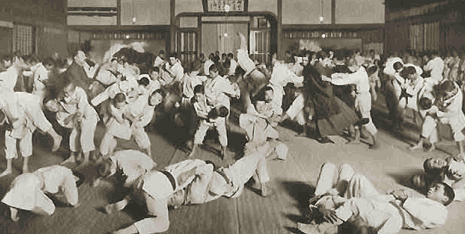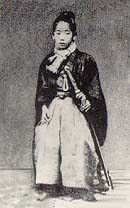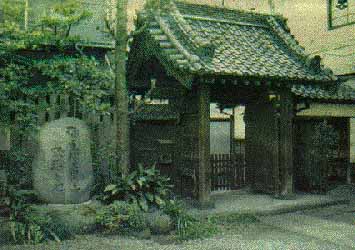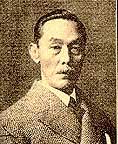by Kazuzo Kudo, 9th dan (1967)The puny prodigy In 1871, at the age of eleven, Jigoro Kano came with his father from Hyogo Prefecture to live in Kakigara-cho in Nihombashi, Tokyo. He began studying calligraphy at Yanokura in Ryogoku and English with Shuhei Mizukuri, in Kanda. In 1873, he finally left his parents’ wings and became a student at a private school in Karasumori, Shiba. Though he was known as a child prodigy and was second to none in his studies, his body was weak, and his classmates used to bully him. Despite his success with his school work, this physical weakness caused him a great deal of anxiety, and he spent long hours day and night trying to find some way to remedy the situation. The decision to practice jujutsuOne day, he recalled that when very small he had heard of a thing called jujutsu that brings strength to the weak, and he decided to follow jujutsu training. It was Kano’s own fierce determination not to give in that lead him to make this decision. Among the people who frequented Kano’s home was a certain Umenari Nakai, a former vassal of the shogun, and a man fairly advanced in the study of jujutsu in the Kyushin school. Kano badgered this man to teach him jujutsu, but Nakai would only laugh and pay the boy no attention. At the Kano’s summer house in Koishikawa a certain Ryuji Katagiri would sometimes show him some jujutsu formal exercises but would only laugh and say that the boy was too young to try any serious jujutsu training. Jigoro also turned for instructions to Genshiro Imai, another friend of the Kano house who studied the Kyushin school of jujutsu, but once again met with no help. Entry into the Tokyo Imperial UniversityThe more people refused to be his jujutsu partners or teachers the more determined Kano became to pursue his course, but he came to the conclusion that relying on others would never spell the fulfillment of his dream. He resolved to search the city for a teacher for himself. Meanwhile, Kano had reached the age of 18, and at the foundation of what was formerly the Tokyo Imperial University (today’s Tokyo University), he entered that school’s literature department with its second group of students. He remained convinced that God helps those who help themselves, and one day he learned that osteopaths were former jujutsu men. When he had time off from his studies, he would go about searching for osteopath signboards, find one, go in, and ask whether the man was a jujutsu practitioner. Perseverance pays offOne day as Kano was walking in Ningyo-cho in Nihombashi he spied an osteopath’s signboard, went in, and found himself in the house of Teinosuke Yagi. Yagi listened to Kano’s request for assistance, sat and thought a while, then said, “I will introduce you to a good man. In Moto-daiku-machi, in Nihombashi, is a man who studied with me named Hachinosuke Fukuda. He should be running a training hall. Go see if you can find him.” Kano immediately did as he was instructed and found the place, a room of about ten tatami mats, one mat of which was taken up with a staircase, and the other nine mats of which doubled as a jujutsu training hall and as a waiting room for Fukuda’s osteopathy patients. At last, Kano was on the road to realizing the wish of his heart. He began studying jujutsu with Fukuda. Formal excercises follow freestyle fightingHachinosuke Fukuda, at that time 47 or 48 years old, was better at the techniques than at the formal exercises. His teaching procedure was to give a once-through explanation of the formal exercises and then to feature only practice freestyle fighting in his instruction. The Kodokan practice of teaching beginners the basic elements of judo, having them practice freestyle fighting, and only then, when they have reached a certain degree of proficiency, to instruct them in the formal exercises arose probably from Kano’s experience with a later teacher named Iikubo. In fact, rather than begin with the formal exercises, as most of the jujutsu schools of Kano’s time did, beginning with freestyle fighting is much more interesting. The blessing of good teachersIn August of 1879, Fukuda, then 52 years old, fell ill and died. Immediately after that, Kano entered the Masatomo Iso jujutsu school. Iso, as the third master of the Tenshinshinyo school, ran a training hall in Kanda, Tokyo, and at that time 62 years old, was a small man only 5 feet tall but with disciplined arms and legs as strong as steel and a personality in keeping with his mystical purposes. Kano himself praises the Tenshinshinyo training by saying that no other was as good in the formal exercises. When we think of it, we can see how really fortunate Kano was in his teachers. First Fukuda gave him outstanding instruction in freestyle fighting, and later Iso taught him the formal exercises. The man doing the instructing is of inestimable importance in deciding whether a pupil will succeed or fail in judo. Perhaps the kind of good fortune in teachers that Jigoro Kano enjoyed naturally comes to anyone with a will as strong as his. The need for constant austerityWhile at the Tenshinshinyo training hall, Kano continued his discipline till he achieved the title shihan, or master. As he has written himself, at first he would instruct 20 or 30 people in the formal exercises then move on to freestyle fighting. This continued day after day, till late at night when Kano was at the point of exhaustion. When practice was over and he started on the homeward path, he would have to stop every ten or twenty paces and rest. Once he got into bed, dreams of tomoe-nage and kata-guruma wracked his brain. He would call out in his sleep or kick out the sliding panels between his and the next room and give his fellow lodgers the surprise of their lives. In 1881, Iso took ill, and later Kano met Tsunetoshi Iikubo, a teacher of Kito Jujutsu. The story of the kata-gurumaJigoro Kano never missed a day going to Iikubo’s training hall, and if his teacher could not for some reason or another hold practice, Kano would practice alone or with any other of the pupils who happened along. Together with Kano at Iikubo’s training hall was a strapping young man named Kenkichi Fukushima, who weighed about 208 pounds to Kano’s very puny 99 pounds. Although Kano had no reason to think he could beat Fukushima, he wanted to throw him more than anything. He studied sumo and physical training books from other countries, until one day he came up with an idea he thought he would try. He lifted hefty Fukushima onto his shoulders and tossed him down as nice as you please. The technique he used was what we now call the kata-guruma. Judo practice suits of those days had short sleeves that did not come below the elbow and pants that left the whole kneecap exposed. Everyday in his rough training sessions Kano would scrape and scratch his body till he was a mass of wounds and till the men at the university lodgings dubbed him the “medicine man.” Just when the judo suit assumed its present form is not clear, but we know that, in about 1907, Kano ordered a new suit designed out of reasons of dignity and good health. The move to the temple In February of 1882, Jigoro Kano, then a 23-year-old literature teacher freshly graduated from the Tokyo Imperial University, took his private students, a certain young Yamada and others, with him when he moved to a temple called the Eishoji in Inari-machi, Shitaya, Tokyo. Yamada was to become a member of the house of Tomita, take the name Tsunejiro Tomita, and become the father of Tsuneo Tomita (sixth dan), the author of Sugata Sanshiro, a famous novel. Tsunejiro was four or five years younger than Kano. Kano believed that judo demands daily practice, but be was unable then to find a suitable place in which to work out. Since he could do nothing else, he decided to quickly convert a fairly large (12 tatami mats) study in the temple into a training hall. The tumbling mortuary tabletsThe room next to this study-training hall was the main hall of the temple, where on either side of the main image were lined up hundreds of Buddhist memorial mortuary tablets donated by worshipers. When Kano and his students would begin judo practice, these tablets would start a sort of helter-skelter freestyle battle of their own, dancing around, falling over, and tumbling down. When a throw was particularly violent and the resulting fall a strong one, down came the memorial tablets clattering against the wooden temple hall floor. Sometimes the floor in the training room would give way, and at night Yamada would tie a towel around his head, creep under the cobweb covered porch, and with Kano holding a paper lantern and pointing first to one place then another, crawl around under the floor making the necessary repairs. The head of the temple had a sour faceThe head of the temple, a man named Choshumpo, as we might expect, looked decidedly askance on these proceedings. Though he was a man of strong will and fortitude, he finally reached the end of his tether and marched into the room where four or five of Kano’s students were gathered. He stood for a minute, then muttered, “He may be young, but Mr. Kano is really an outstanding man. What a fine person he would be if would just leave this judo alone!” The priest turned and left. Soon spring came to the Eishoji, then summer passed, and Kano and his students continued their daily training. In those days, Kano occupied the important position of principal of the Gakushuin, a well-known school for the children of the well-to-do. Every morning he would ride to work in a jinrikisha, then a fashionable mode of transportation, but before he went he would have to spend two hours instructing at his own Kobunkan, an institute he created not only for judo, but for other studies as well. Everyday after work at the Gakushuin — judo practice. Then, at night — lecture preparations for the following day. Since he had no other time to do it, he would work at translations until one or two in the morning.
Small training hall on a vacant lotJigoro Kano would sometimes prepare a sweetened barley tea to give his students to drink or have the old lady who prepared food at the temple make a mixture of rice and lotus roots, taken from the pond in front of the study room, to give them to eat. He would provide students who could not afford them with practice clothes which he also had laundered. Yamada and the other students who lived with Kano were in charge of the laundering. Two or three times a week, Tsunetoshi Iikubo would come to the Eishoji to instruct. When he did, training became even more violent, until the head of the temple came to Kano and told him that he must either leave the temple or give up practicing judo there. Fortunately, Kano got permission to use a vacant lot adjacent to the temple, and there, in the early autumn of 1882, he built a tiny training hall, two bays (approximately 12 feet) by three bays (approximately 18 feet). The student throws the teacherIn September, 1883, Kano moved from Imagawa-koji to a part of town called Koji-machi to a new training hall twenty tatami mats in size. Since the days of the Eishoji, Tsunetoshi Iikubo had been coming to the hall to instruct in Kito-style jujutsu. He was a man of fine character and lofty views who had instructed Kito jujutsu for the shogunate at the end of the Edo period. Kano met him through Seio Motoyama who also taught for the shogunate and who was also a follower of the Kito style of jujutsu. One day, following Iikubo’s example, Kano was taking part in a particularly violent freestyle practice fight. On this occasion Iikubo had not managed to throw Kano a single time. In fact, using his uki-waza and his sumi-otoshi, in both of which he was very good, Kano had already thrown Iikubo three times. Until then, Kano had never gotten the better of Iikubo, who was dumbfounded and could not imagine what had happened. The title of teacher changes handsKano then explained, “From what I have learned in practicing with you I have been thinking. It came to me that when you push or pull your opponent — of course you must move yourself — you force his body to lean in one direction or another and to fall into an unstable position. You then use his lack of balance to apply your technique. To be able to easily down your opponent you must force him to shift his weight off of the part of his body that is actually supporting it. Of course, to do this you must get yourself into a position from which it is easy to work. Your opponent will then tighten his body, straighten it out like a ramrod, and reach that point of no return from which he can neither advance nor retreat. This is when you attack. In other words, you force your opponent to make his body rigid and to lose his balance, and then he is helpless. I have been training and studying up till today to see if this theory would work in actual practice.” Iikubo listened in silence, then when Kano was finished, said, “From now on I will be the one whom you teach. I cannot keep up with you. From this day on I want you to discipline and train by yourself.” The secret of kuzushiVery soon Iikubo gave up teaching, and in October of that same year, Kano received his accreditation in Kito jujutsu. In this way Kano discovered the great law of kuzushi, or the way to force your opponent off balance, and when I comment on his fame and greatness it is to this that I refer. Although people all over the world recognize Jigoro Kano as the founder of judo, not many of them give him his just due as a truly great judo expert, because his discovery of this vital principle — a discovery that his predecessors could not make — is not as well known as it should be. The birth of judo As Kano gave still further thought to this principle and attempted to extend its applications he became confident of the possibility of creating and developing what is today called judo. It was after this that the name Kodokan (the hall where the way is taught) and the terms Japanese Kodokan judo first came into being. In 1884, the hall bylaws were drawn up, though students names in the register date back to 1882. Heading the list is Tsunejiro Tomita, and following his name is that of Seiko Higuchi (who later became a viscount). The famous Shiro Saigo entered the Kodokan, in August of the same year, at the age of sixteen as the eighth member. From that time on, the activities at the hall followed one right after the other. There was the New Year’s Morning Ceremony, (no longer observed), the Kagamibiraki ceremony (still held on the second Sunday of January), The Great Red and White Meets in the spring and fall, the Tsukinami Meet, and the promotion ceremony. The fiftieth anniversary of the foundingIn 1934, at the Suidobashi Tokyo training hall, the Kodokan celebrated the fiftieth anniversary of its founding. Members came from all over the country to participate in a great ceremony held in the presence of an imperial prince. On that occasion, Kano presented envelopes containing some of the money he had received from the emperor to the memorial plaques of each of his teachers and made an expression of gratitude for all that they had done for him. As I (sixth dan at that time) stood among the other participants in the ceremony in a corner of the training hall and listened, I recalled what he had said to us many times before in daily training and what he had written often in his books.
This is a deeply touching statement of the man’s most cherished belief. Perhaps from Kano’s standpoint a great deal of judo lies ahead. The road is a long one, but if the fifty years he spent in learning the jujutsu that he desired so strongly, in creating and inspiring the development and spread of judo, and in exerting an incalculable influence on the world and people around him does not stand for the fulfillment of his cherished dream, I am at a loss to know what would. At a recent exhibition, Kano’s judo practice suit from his training days was on display. The outside is of brown linen and the inside of cotton. When he would tear it, Kano would fix it himself with kite twine. The bottom of the jacket is in tatters, a clear indication of the violence of his training sessions. Many people stopped to look at this real reminder, discolored with sweat and oil, of the real strength of the man. After the fiftieth anniversaryFive years ago, in 1962 at the new Kodokan in Kasuga-cho, Tokyo, we held a celebration of the eightieth year since the founding. People gathered from all over the country and both the Kodokan and Risei Kano, the son of the founder, sent remembrances in honor of the occasion to judo men all over the world. Judo’s glory lives and will continue forever! Judo: the art of self-perfection.  |




